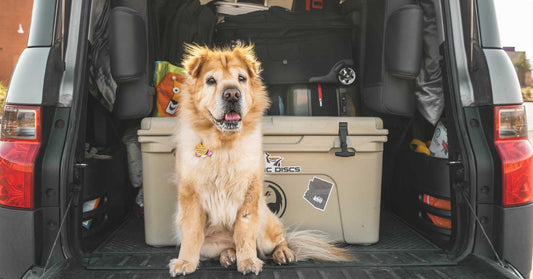As much as we love our furry friends, it’s important to think about safety, especially taking your pup on a drive. Driving with dogs in the car can present several challenges and dangers for both you and your pet, so it's important to be well-informed before hitting the road.
To help you out, we've put together a list of answers to some of the most popular questions and tips for traveling with dogs by car!
What are the risks of driving with dogs in the car?
There are several risks associated with driving with dogs in the car, the most significant of which is distracted driving. According to a study by the AAA Foundation for Traffic Safety, 16 percent of fatal crashes in the United States involve distraction from an animal in the car.
Other risks include your dog getting motion sickness, jumping out of an open window, or blocking your view while you're driving.
1. Dog Restrained in The Car: Yes or No?
Road trip with your pup, and there's a question: do you have to restrain your dog in the car? While there is no federal law in the United States requiring dogs to be restrained while riding in cars, many states have their own laws about dogs in cars while driving. For example, in Minnesota and Massachusetts, it is illegal to drive with an unrestrained dog in the car.
Just like you wouldn't drive with a baby unrestrained, the same should go for your pup - they can't react to situations on the road, and won't be able to brace for impact in case of an accident.
2. Do Dogs Need Seatbelts?
When it comes to car rides with dogs, there's always a question - do dogs need seat belts? In most cases, a seatbelt should be used to help you restrain and protect your pup.
There are a few different ways that you can restrain your dog while driving, depending on your pet's size and personality. It's important to always do your research on how to keep your dog safe in the car to choose an appropriate restraining device.
For small dogs, the best option is often a carrier that attaches to the seatbelt. This type of carrier will keep your dog secure and prevent them from moving around the car while you're driving.
For medium and large dogs, a harness that attaches to the seatbelt is a good option. This will allow your dog to sit or lie down while still being restrained.
Another option for restraining dogs in cars is a crate. Crates can be placed in the backseat or trunk of the car and can provide a safe and secure space and help you keep your dog restrained in the car.
Finally, some people choose to use a pet seatbelt. These devices attach to your dog's harness and allow them to move around while still being restrained.

3. Can Dogs Ride in The Front Seat?
Whether your dog can ride in the front seat depends on a number of factors, including the size of your dog and the type of car you are driving.
In general, however, it is advisable to keep small dogs in the backseat and larger dogs in the front seat. This will minimize the risk of distraction and injury in the event of an accident. Some car manufacturers have specific rules about where dogs can ride in their vehicles.

4. How Often to Stop on a Road Trip With a Dog?
How often you stop on a road trip with your dog will depend on several factors, including your pet's size, age, and health.
In general, it is a good idea to stop every 2-3 hours to give your dog a break. This will allow them to relieve themselves and stretch their legs.
If your dog is small or elderly, you may need to stop more frequently. Similarly, if your dog is prone to motion sickness, you may need to make more frequent stops.
Finally, keep in mind that you should never leave your dog alone in the car. If you need to stop for an extended period, it is best to find a pet-friendly hotel or campground where your dog can stay with you. Dogs might suffer from extreme overheating when being locked in a car by themselves.
5. Must-Haves for a Road Trip With a Dog
When packing for a road trip with your pup, there are a few essential items that you will need to bring.
First, be sure to pack enough food and water for your dog. It is also a good idea to bring along some treats and a few toys to keep your dog entertained.
You will also need to bring some poop bags and a bandana. The bandana can be used to help keep your dog cool in the summer heat.
It might be a good idea to consult a vet if this is your first trip with a new dog to get some tips for keeping your dog calm and dealing with anxiety.
Finally, be sure to pack a first-aid kit for your dog. This should include items like gauze, disinfectant, and tweezers.
6. How Long Can a Dog Travel in a Car?
There is no definitive answer to this question as it depends on a number of factors, including your dog's size, age, and health.
In general, however, it is safe to travel with your dog for 3-4 hours at a time. If you are planning a longer road trip, it is best to break up the journey into several shorter legs. This will allow your dog to rest and stretch their legs regularly.

7. Can Dogs Get Car Sick?
Yup, they can! There are a few tips on how to prevent your dog from getting car sick.
First, feed your dog a light meal before getting in the car. This will help to settle their stomach.
Second, try to avoid feeding your dog in the car. If they do need to eat, stop the car and let them eat.
Finally, keep the car cool and well-ventilated. This will help to prevent your dog from getting too hot and nauseous.
If your dog does start to get car sick, stop the car as soon as possible and let them out. Once they have relieved themselves, give them a small amount of water and continue on your journey.
Overall, a road trip with a dog is a great way to bond with your furry friend and explore new places together. Just be sure to do your research beforehand and pack all the essentials. With a little preparation, you and your dog will have a safe and enjoyable trip!






